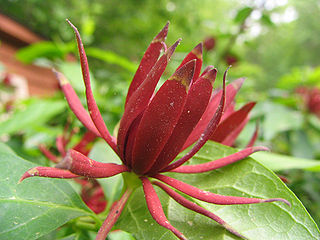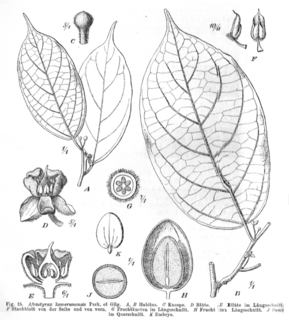
Ceratophyllaceae is a cosmopolitan family of flowering plants including one living genus commonly found in ponds, marshes, and quiet streams in tropical and in temperate regions. It is the only extant family in the order Ceratophyllales. Species are commonly called coontails or hornworts, although hornwort is also used for unrelated plants of the division Anthocerotophyta.

Gunneraceae is a family of flowering plants, closely related to Myrothamnaceae, together forming the order Gunnerales. Such a family has been recognized by most taxonomists. Gunneraceae consists of the single genus Gunnera with 63 known species.

Basellaceae is a family of flowering plants, in the order Caryophyllales in the clade core eudicots, according to the Angiosperm Phylogeny Group. The family comprises ca 19 known species of herbaceous plants, some with climbing habits, in four genera:

The Calycanthaceae are a small family of flowering plants in the order Laurales. The family contains three genera and only 10 known species, restricted to warm temperate and tropical regions:

Hypoxidaceae is a family of flowering plants, placed in the order Asparagales of the monocots.

Bonnetiaceae is a family of flowering plants, consisting of 4 genera and 41 species. The family is Neotropical, with the exception of the genus Ploiarium, which is found in Malesia. It is sister to the family Clusiaceae.

Caryocaraceae is a small family of flowering plants consisting of two genera with 26 species. The family is native to tropical regions of Central and South America, as well as the West Indies.
Ctenolophon is the only genus in the flowering plant family Ctenolophonaceae. It has two recognized species:

Dichapetalaceae is a family of flowering plants, consisting of 3 genera and about 170 species. Members of this family are trees, shrubs or lianas found in tropical and subtropical regions of the world.

Erythroxylaceae is a family of flowering trees and shrubs consisting of 4 genera and 271 species. The four genera are AneulophusBenth., ErythroxylumP.Browne, NectaropetalumEngl., and PinacopodiumExell & Mendonça. The best-known species are the coca plants, including the species Erythroxylum coca, the source of the drug cocaine.

Irvingiaceae is a family of flowering plants, consisting of 13 species in the 3 genera Allantospermum, Irvingia and Klainedoxa. Desbordesia, formerly accepted is now included in Irvingia.

Myrothamnus is a genus of flowering plants, consisting of two species of small xerophytic shrubs, in the southern parts of tropical Africa and in Madagascar. Myrothamnus is recognized as the only genus in the family Myrothamnaceae.

Dasypogonaceae is a family of flowering plants, one that has not been commonly recognized by taxonomists; the plants it contains were usually included in the family Xanthorrhoeaceae. If valid, Dasypogonaceae includes four genera with 16 species.

The Muntingiaceae are a family of flowering plants, belonging to the rosid order Malvales. The family consists of three genera: Dicraspidia, Muntingia, and Neotessmannia, each with a single species. They are woody plants of the tropical regions of America. The older Cronquist system placed these genera in the family Tiliaceae, with which they share morphological similarities, but have no evolutionary affinity. Muntingia calabura is widely introduced in tropical regions, because of its edible fruit. Dicraspidia donnell-smithii and Neotessmannia uniflora are the other two species in the family, the latter only known from herbarium specimens.

Tecophilaeaceae is a family of flowering plants, placed in the order Asparagales of the monocots. It consists of nine genera with a total of 27 species.

The Neuradaceae are a family of flowering plant, comprising three genera — Grielum, Neurada and Neuradopsis — totalling ten known species.

Nitrariaceae is a family of flowering plants in the order Sapindales. It comprises four genera, Malacocarpus, Nitraria, Peganum and Tetradiclis, totalling 19 species.

Huaceae is a family of plant in the rosids group, which has been classed in the orders Malpighiales, Malvales, and Violales or in its own order Huales. The APG II system placed it in the clade eurosids I, whereas the APG III system of 2009 and APG IV (2016) place it within the Oxalidales. The family is endemic to central Africa. It contains four species in the following two genera:

Calophyllaceae is a family of flowering plants in the order Malpighiales and is recognized by the APG III system of classification. Most of the 14 genera and 475 species included in this family were previously recognized in the tribe Calophylleae of the family Clusiaceae. The Angiosperm Phylogeny Group determined that splitting this clade of genera off into their own family was necessary.

Centroplacaceae is a family of flowering plants in the order Malpighiales and is recognized by the APG III system of classification. The family comprises two genera: Bhesa, which was formerly recognized in the Celastraceae, and Centroplacus, which was formerly recognized in the Euphorbiaceae, together comprising six species. The Angiosperm Phylogeny Group determined that based on previous phylogenetic analysis, these two genera formed an isolated clade and recognition of the family was "reasonable."



















